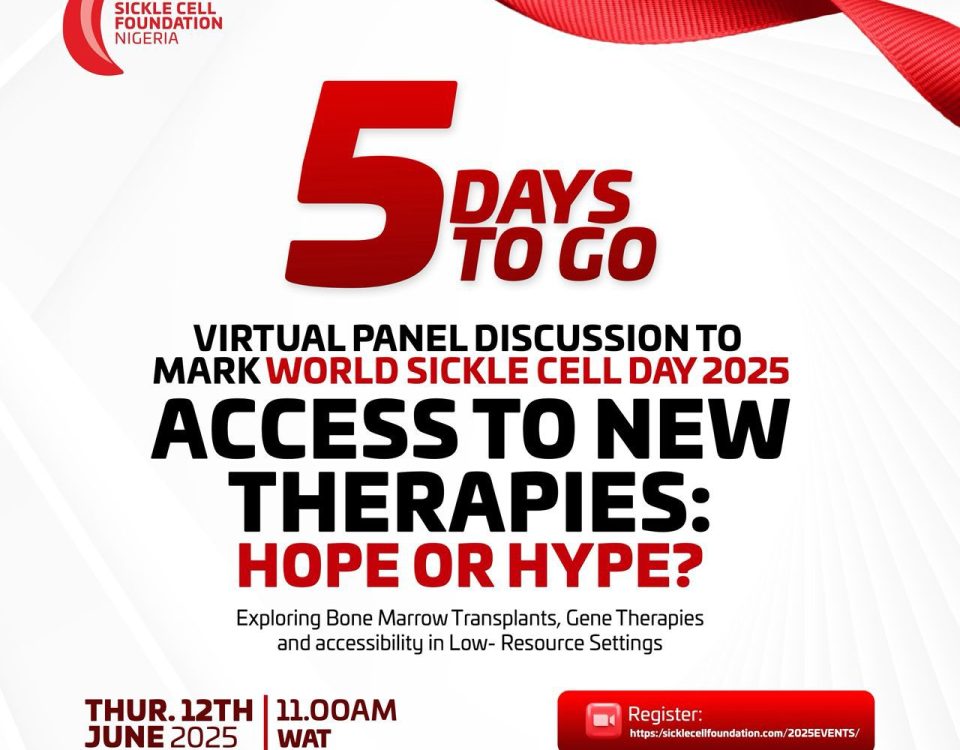SICKLE CELL DISORDER: IMPORTANCE OF SELF-CARE (PART TWO)

VISIT OF VANDERBILT UNIVERSITY MEDICAL CENTRE TEAM TO THE BONE MARROW TRANSPLANT CENTRE
December 13, 2023
Improving Hydration for Sickle Cell Warriors by Bukola Bolarinwa
December 13, 2023
SICKLE CELL DISORDER: IMPORTANCE OF SELF-CARE (PART TWO)
Prof. Norah O. Akinola, FACP
PhD, FMCP, FMCPath
Department of Haematology and Blood Transfusion,
Obafemi Awolowo University Teaching Hospitals Complex,
Ile-Ife, Osun State, Nigeria.
Basic Information about Sickle Cell Disease
Variability of the Severity of Sickle Cell Disease
- The clinical features of SCD are variable from person to person and within an individual with time.
- The severity is related to genes inherited, the quality of care received and environmental factors like exposure to infections, particularly, malaria.
- The amount of haemoglobin F inherited plays a major role in the severity of the disease, therefore it is known as a marker of disease severity. There are other markers like the steady state white blood cell count, which is a risk factor for sudden death, acute chest syndrome and severe disease when it is higher than 15,000 x 109/ul.
Table 3: Haemoglobin Profile of Adults with Sickle Cell Disorders
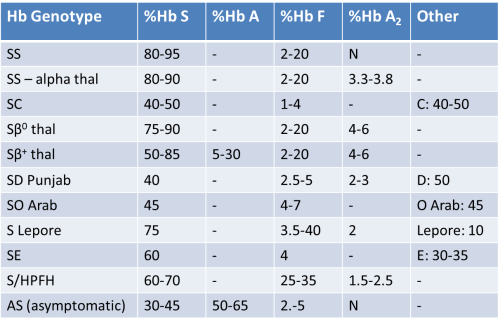
Table 3: Haemoglobin Profile of Adults with Sickle Cell Disorders
If you remove the Hb AS from this Table, it becomes a Table of sickle cell diseases.
Precipitating (Trigger) Factors of Crises
- Dehydration (water is an essential food which is needed to prevented painful crisis and also preserve the kidney function)
- Infection (especially malaria, encapsulated organisms due to hyposplenism/asplenism)
60% of admissions from painful crises in our emergency rooms are due to malaria infection. Other infections may also affect the kidneys, so there is a lot in common between SCD and kidney disease.
- Extremes of temperature – extremes of temperature should be avoided
- Stress
- Emotional disturbance
- Physical (exhaustion) – patients should know their exercise tolerance level.
- Pregnancy is a high-risk condition for females with SCD.
Vaso-occlusive Crisis
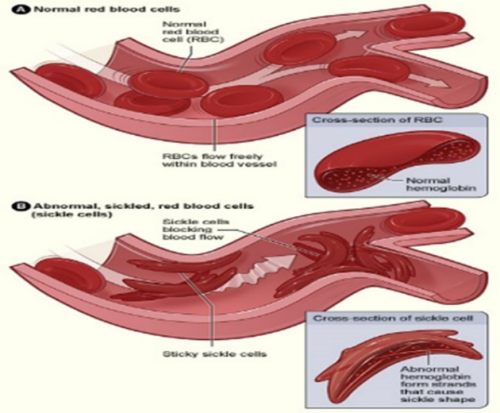
Figure 7. Pathogenesis of Vaso-occlusion
The vessel on the top shows free flowing red cells that can change their shape as they go through smaller vessels (capillaries) without causing obstruction (Figure 7).
The vessel below shows what happens in vaso-occlusive crisis, otherwise known as painful crisis, when red blood cells sickle due to deprivation of oxygen (hypoxia). Sickled cells become rigid and sticky and adhere to the walls of the vessels (vascular endothelium), trap other blood cells (white cells and platelets) and obstruct the flow of blood.
This results in the production of certain chemicals (cytokines) that promote acute inflammation and produce pain (ischaemia). This process may worsen the hypoxia (low oxygen delivery) and cause more sickling, which leads into a vicious cycle that may cause death of tissue (infarction), if not abated.
This process of vaso-occlusion has been found to occur in the steady state without overt pain and it is associated with the development of chronic complications of the disease. This means that almost every part of the body is affected by the sickling process, from the head to the toe. Sickle cell disease is a life-long disease, so it is better for affected individuals to learn to live with it as early as possible. Figure 8 shows the common acute or chronic complications that may occur in SCD. A common example particularly in children is stroke. The risk of developing a stroke under the age of 16 years may be monitored with the use of Transcranial Doppler (TCD) ultrasound of the vessels in the brain. It enables children at risk to be detected and given the necessary treatment/intervention to prevent stroke. The eyes may also be affected to the extent that the sickling process may cause changes that may result in blindness, when there is vitreous haemorrhage or retinal detachment, particularly in individuals with Hb SC disease. Haemoglobin C increases the whole blood viscosity, because the steady state haematocrit in them is higher than those with Hb SS.
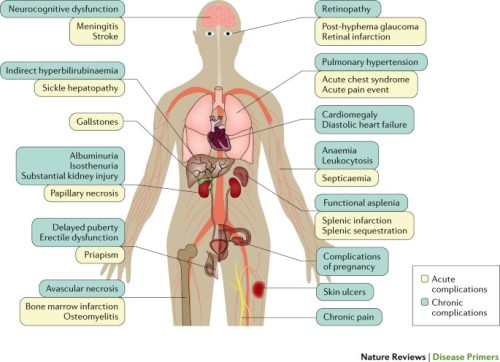
Figure 8. Complications of Sickle Cell Disease
Sickle cell disease affects end organs without collateral circulation. The heart is a common organ to be affected because it has to work extra hard to maintain oxygen delivery to other organs in the presence of anaemia, which is characteristic of SCD. The lungs may be affected with acute manifestations such as painful episodes and acute chest syndrome, which is associated with cyanosis (blue discolouration of the skin and buccal mucosa). Such individuals need oxygen therapy to survive. The liver may be affected because it is the organ that breaks down haemoglobin, from the destroyed red cells (haemolysis), into bilirubin, which causes the yellow discolouration of the eyes called, jaundice. Since the life span of the red cells in SCD is shorter than the normal 120 days, it may be anything between 5 to 50 days depending on the prevailing circumstances, individuals with SCD often have jaundice. The rapid return over of red cells makes SCD a chronic haemolytic anaemia, which is characterised by increased production of red cells by the bone marrow, evidenced by increase in the reticulocytes (young red cells) and sometimes the presence of nucleated red cells (immature red cells). Chronic haemolysis may give rise to gall stones and deepening of the jaundice, which may have a greenish tinge in colour. The hormone responsible for the production of red cells is produced by the kidneys and it is called erythropoietin (EPO). The levels of EPO are high until the kidneys fail and it is only then that EPO may be used to increase red cell production. The affectation of the bones, giving rise to pains, is the hallmark of SCD. The rheological study of the red blood cells (RBC) in SCD shows that there is a prodromal period during which affected individuals feel that they are about to have a crisis. The established phase of vaso-occlusive crisis (VOC) may be averted if the prodromal phase is heeded to on time. Ballas et al (1992) and Akinola et al (1992) showed that VOC has four phases namely, prodromal, onset, established (peak) and recovery that have corresponding rheological changes in the RBCs and lasting for about 5 to 7 days, if not complicated with osteomyelitis or infarction of tissue. Repeated splenic infarction results in replacement of the spleen with fibrous tissue that causes medical (auto) splenectomy. It has been observed that about 12% of children still have large spleens by the time they reach the age of 16years.
So, any part of the body may be affected, even the legs, where there may be chronic ulcers. This is fairly common among our patients here in Nigeria. Among males there may also be priapism, which is defined as painful penile erection. It is a very sensitive area and mothers must be attentive, because it may affect boys under the age of 10 years. It is not an adult only feature. Priapism starts as stuttering i.e. it comes and goes, but does not last for more than two or three hours at a time. It may however, become prolonged and established if it is not taken care of properly and this may lead to impotence if surgical intervention is needed to reach detumescence. The priapism associated with SCD is usually ischaemic in nature due to vasoconstriction (narrowing) of the veins, as opposed to the high flow type.
Morbidity and Mortality across the Lifespan
- Mortality increases with age, with a rate of 1 – 2% in newborns and up to 50% in under 5s, but about 0.5% in adults in sub-Saharan Africa.
- This mortality rate accounts for 9 – 16% of the overall under 5 mortality in many West African countries.
- In the US, over 90% of affected children survive into adulthood.
- In the UK over 99% of those born with SCD will survive to adulthood and the mean life expectancy is in the 60s; whereas it is less than 45 years in Nigerians.
The Importance of Newborn Screening for Sickle Cell Disease

Comprehensive Newborn Screening Programme for Sickle Cell Disorders in SW Nigeria is a Collaboration between two NGOs and a Teaching Hospital in SW Nigeria
• Global Sickle Cell Alliance Inc. (GLOSCA), USA.
• Mustard Seed Health Aware Initiative (MSHAI), Ile-Ife, Osun State, Nigeria.
• Obafemi Awolowo University Teaching Hospitals Complex, Ile-Ife, Osun State, Nigeria.
Newborn screening is the way forward to reduce morbidity and mortality of children with SCD and promote long and good quality lives. Newborn screening is composed of the 3T’s and the 2E’s, i.e. testing, tracking and treatment (comprehensive care); education and evaluation.
Diagnosis of SCD
Sickle cell disorders may be diagnosed using many methods.
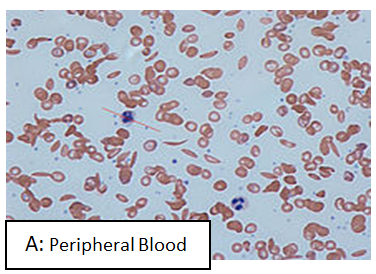
Screening methods include:
- Blood film (and a full blood count that shows moderate to severe anaemia, and sickled cell in the peripheral blood film)
- Sickling and Solubility tests
Disgnostic methods include:
- Haemoglobin phenotype using different methods
- HemoTypeSC (Point of Care test)
- Cellulose acetate at pH 8.9 (baby needs to be more than 6 months old to do this test)
- Agarose gel at pH 6.0
- Iso-electric focusing (used for newborn screening) Figure 9: Screening Tests for SCD
- HPLC (may also be used for newborn screening)

Confirmation tests are molecular biology tests that include:
- Genetic finger printing (Hb genotype) DNA analysis using:
- Polymerase Chain Reaction (PCR) and Southern Blot Technology,
- Restriction fragment length polymorphism (RFLP),
- Oligonucleotide primers; and
- New generation sequencing (NGS)
The holly leave simulates what reversibly sickled cells look like, but they are much larger and green instead of red. At a conference in Leicester, UK, many years ago, painful crisis was described by some individuals living with SCD, as Brillo pads passing through the vessels at the same time. Brillo pads are fine wire mesh soaked in soap and used to wash very dirty/stained pots/pans. So, you can therefore, imagine how painful VOC may be for someone living from SCD. The pain of VOC has been described to be more severe than toothache, labour pains and fracture pains.
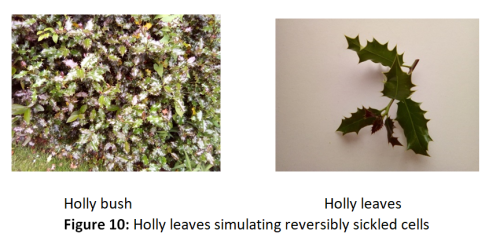
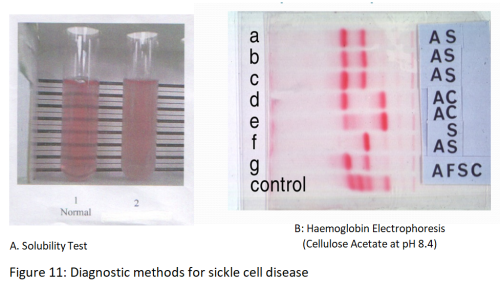

Figure 12: Point-of-Care Method: Samples of cassettes from SickleSCANTM screening tests showing the separation of the various haemoglobins, Hb A, S and C (Nwegbu et al., 2017).
To be continued in part 3.




